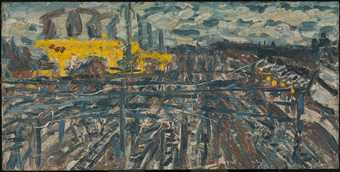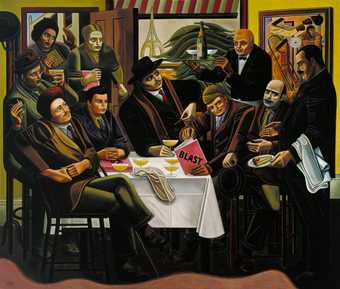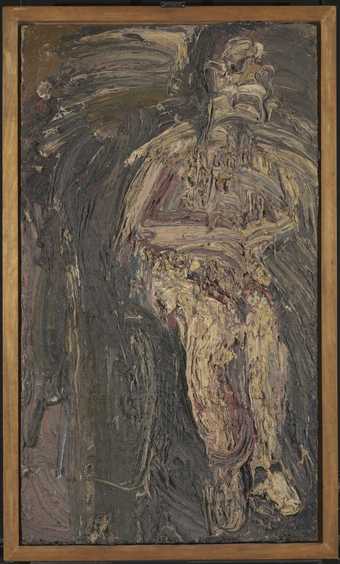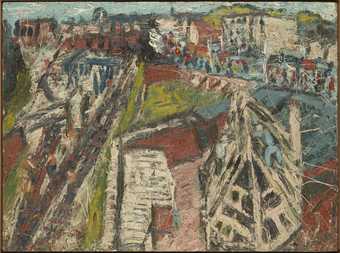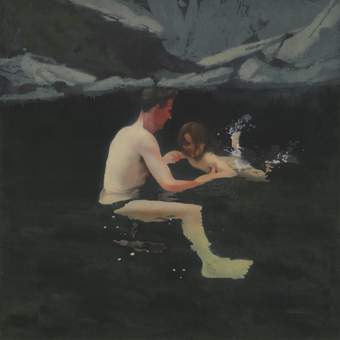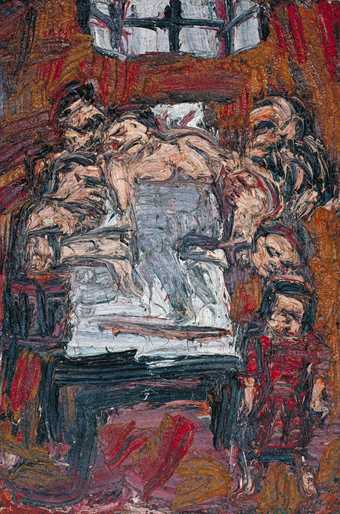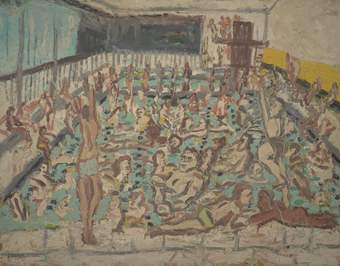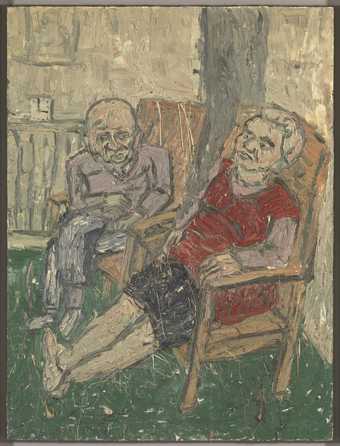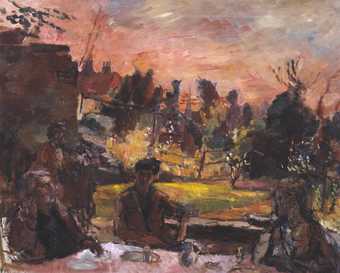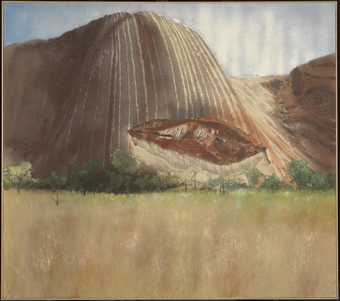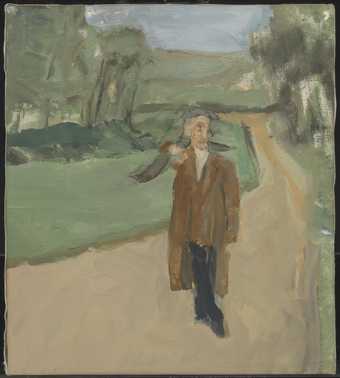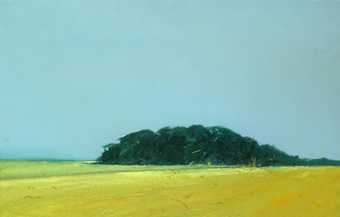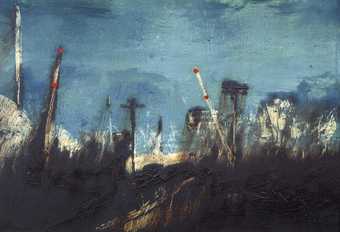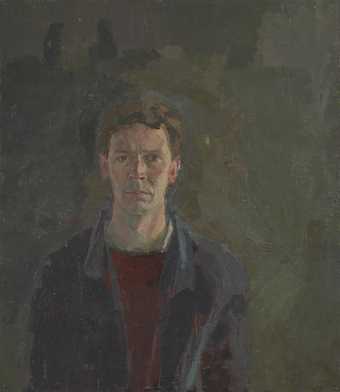
Not on display
- Artist
- Michael Andrews 1928–1995
- Medium
- Oil paint on board
- Dimensions
- Support: 2140 × 2445 mm
frame: 2149 × 2452 × 40 mm - Collection
- Tate
- Acquisition
- Purchased 1974
- Reference
- T01897
Display caption
'The Deer Park' was inspired by Norman Mailer's novel of the same title. For Andrews, the novel seemed to describe 'the world of Soho' whose clubs and bars he had frequented. Rather than illustrating the text, however, the painting creates a new, imaginary situation involving a cast of different characters. Its subject is social behaviour 'where people are relaxed and project images close to themselves'. The figures are all based on photographs of people from show business and literary worlds, past and present. They include Marilyn Monroe, Brigitte Bardot and the poet Rimbaud. The background is based on 'The Boar Hunt' by Velasquez in the National Gallery, London.
Gallery label, August 2004
Does this text contain inaccurate information or language that you feel we should improve or change? We would like to hear from you.
Catalogue entry
T01897 THE DEER PARK 1962
Inscribed on back ‘The Deerpark 1961 Michael Andrews’
Oil on board, 84 1/4×96 1/4 (214×244.5)
Purchased from Charles Grant (Grant-in-Aid) 1974
Coll: Charles Grant (purchased from the Beaux Art Gallery 1963)
Exh: Michael Andrews, Beaux Arts Gallery, London, January–February 1963 (20); British Painting in the Sixties, Whitechapel Art Gallery, June 1963 (118, repr.)
Lit: David Sylvester, ‘Art in a Coke Climate’, Sunday Times Colour Supplement, January 26, 1964, p.20 (repr. in colour); Bryan Robertson, John Russell and Lord Snowdon, Private View, 1965, pp.260–63, (repr.in colour)
‘The Deerpark’ was painted in late 1962 (not in 1961 as inscribed on the back of the picture) in Michael Andrews' studio, a room in his flat at 3 Duncan Terrace, London Nl. The room is shown on p.260 of Bryan Robertson et al.op. cit.
In October–November 1962 Andrews was painting ‘The Colony Room’, which was based on the Colony Room Club, 41 Dean Street in Soho which he had frequented since leaving art college in 1954. Other persons regularly using the club at the time included Francis Bacon, Lucian Freud and Rodrigo Moynihan. The world of the painting ‘The Colony Room’ was that of the members of the club including Andrews' friends; he has ‘always been interested in the party situation, where people are relaxed and project images closest to themselves.’
While painting ‘The Colony Room’, Andrews read Norman Mailer's novel The Deer Park, which seemed to Andrews to describe ‘the world of Soho writ large’ and to extend his feelings evoked by the Colony Room Club ‘a broadening of context-cosmological extension’. Andrews says he ‘had to paint “The Deerpark” fast. I became excited to do a painting of the subject when reading Mailer's book. I wanted the picture to be in my show (at the Beaux Arts Gallery in January 1963) even if it was just a large sketch. I killed off any preconceptions about quality and “finish”. I had to go directly from the textures and atmosphere of the book to the painting.’
Andrews painted the picture on board rather than on canvas as he could then ‘push the paint around’. Because the door of the studio was too small, it was necessary to assemble the support for the picture in the room from two pieces of board. Andrews made five scribbled schematic sketches (exhibited in Drawing Towards Painting 2, Arts Council Gallery, London, April–May 1967 and subsequent tour, (5)). He felt that there should be a balcony in the picture and ‘as soon as the wood and veneer of the balcony came right this gave me the structure of the picture’. ‘The atmosphere of the image dictated the structure of the picture. If the mental picture has qualities it has structure. For me structure is always preceded by atmosphere and ambience.’
Andrews felt exhilarated while painting ‘The Deer Park’ and sees it as ‘one of the pictures which has given me the greatest excitement painting. I went directly for excitement.’
Figures in the painting were based on photographs or the artist's recollections of people. The figure in the centre foreground representing Marion Faye in the novel was based on a photograph of Rimbaud taken from a book. It can be seen behind the artist's left shoulder in a photograph of him in his studio reproduced in Private View, p.260. Andrews was reading Rimbaud ‘a lot’ at the time ‘The Deer Park’ was painted. ‘Marion Faye must have had a deadly kind of charm and was guided by fate and Rimbaud was a parallel figure’. The figure on the right was based on a photograph of Ian Fleming the novelist. The dancer in the foreground to the right, together with the crouching man and sitting woman immediately behind her, were based on a press cutting (source unknown) of what appears to be a scene in a night club. The curved sofa and the reclining man in a blue shirt on the left, were based on a coloured photograph of a Californian interior reproduced in an article on California in (?) a Sunday Times colour supplement. The two figures behind the man with straw coloured hair at the back of the sofa, are taken from a photograph of Brigitte Bardot and Sacha Distel in a French language magazine. The two figures on the balcony on the right were based on a photograph of Marilyn Munro and Jose Bolanos published in the Daily Express, 3 March 1962. The male figure standing on the stairs to the balcony was based on a photograph of Alexander Plunkett-Green reproduced in an issue, date unknown, of Vogue.
The enclosed space in the background of the painting is based on the painting ‘The Boarhunt’ by Velasquez and an assistant, in the National Gallery, London. Andrews has always been interested in Velasquez and sees the enclosed area in which the boarhunt took place as ‘a parallel to the enclosed world of the playpen/trap in which the characters in “The Deerpark” moved’.
Published in:
The Tate Gallery 1974-6: Illustrated Catalogue of Acquisitions, London 1978
Explore
- architecture(30,960)
-
- features(8,872)
-
- balcony(141)
- stair / step(514)
- emotions and human qualities(5,345)
-
- exhilaration(50)
- enclosure(72)
- places of entertainment(399)
-
- bar(106)
- eating and drinking(409)
-
- drinking(267)
- dance(296)
- party(106)
- actions: expressive(2,622)
-
- embracing(429)
- group(4,227)
- Balanos, Jose(1)
- Bardot, Brigitte(2)
- Distel, Sacha(1)
- Fleming, Ian(2)
- Monroe, Marilyn(27)
- Plunkett-Green, Alexander(1)
- Rimbaud, Arthur(9)
- groups(310)
- lifestyle and culture(10,247)
-
- cultural icon(63)
- couple(1,322)
- arts and entertainment(7,210)
-
- actor(261)
You might like
-
Leon Kossoff Willesden Junction, Morning in October
1971 -
Michael Andrews A Man who Suddenly Fell Over
1952 -
William Roberts The Vorticists at the Restaurant de la Tour Eiffel: Spring, 1915
1961–2 -
Leon Kossoff Man in a Wheelchair
1959–62 -
Leon Kossoff Demolition of the Old House, Dalston Junction, Summer 1974
1974 -
Michael Andrews Melanie and Me Swimming
1978–9 -
Leon Kossoff Woman Ill in Bed, Surrounded by Family
1965 -
Leon Kossoff Children’s Swimming Pool, Autumn Afternoon
1971 -
Leon Kossoff Two Seated Figures No. 2
1980 -
Nancy Carline Supper on the Terrace
1946 -
Michael Andrews Laughter Uluru (Ayers Rock), The Cathedral I
1985 -
Michael Andrews Study for a Man in a Landscape (Digswell)
1959 -
Colin Self Large Harvest Field and Woods near Happisburgh, Norfolk
1984 -
Colin Self The Crossing
1985 -
Michael Andrews Self-Portrait
1959

